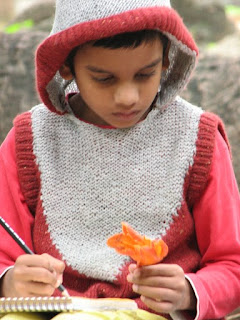(The cover story of the current issue of 'Teacher Plus' is on homeschooling. This article I wrote was published with the cover story. Check out http://www.teacherplus.org if you want to read other related articles)
There are fast-moving white cotton-puff clouds in the bright blue Bangalore sky and through the big window I can see that it’s a beautiful windy day outside. I am sitting in my home-office from where I manage SeasonWatch, an India-wide tree monitoring program for school children, which brings in just enough income for the family. Teacher Plus asked me to write an article about homeschooling and every day for the last month or so, Dinkar, my 10-year old and I have been writing one story each and sharing it with the family in the evenings. Today, I thought I’d combine these two requirements and write an article-story about our homeschooling day.
As it often happens with us, all five of us are at home. So let us go around the house and see what the others are up to. In the children's room, Aditi, our 16 year old, is watching Bharatanatyam videos on YouTube. Aditi is interested in dance but her first love is photography and she is always experimenting with her high-end DSLR camera. The camera is a gift from her aunt for doing well in her NIOS 10th board exams last year. Aditi maintains a photo blog and many people like her work.
Dinkar, who unlike his brother and sister, has never been to school, is sitting on the floor behind Aditi and drawing something. He learnt to read only when he was eight years old but he has been sketching and painting from a very young age. He has a knack of representing scenes with very few lines and he likes drawing cartoons with speech bubbles.
On the dining table, Srikant is reluctantly going through his 7th standard Hindi textbook, which he should have finished two months ago before the end of the last academic year. For two years now, Srikant has been studying completely on his own, but today Kanti is sitting with him to ensure that he does not quietly move to the baithak and curl up with the Terry Pratchett novel that he has obsessively been reading.
Kanti has taken time out of her busy schedule to sit with Srikant. Her time goes in advanced level cooking, such as the multi-grain sourdough bread that she baked for breakfast today, or in experimenting with the technologies of growing
things for our kitchen on our sunny balconies, or in stitching professional looking clothes for the family, or in the hundred other simple things that keep our household ticking and fun.
Today is a Saturday – a busy day. Except for a loosely structured basketball class in the evenings, the weekdays are very flexible and free for the children but the weekends are busy. They have music and dance classes for which they walk a kilometer, catch a BMTC bus, get off and walk another kilometer to Bharatiya Vidya Bhavan for their one or two-hour class. Aditi learns Bharatanatyam and both the boys are learning to play the tabla. Srikant has an additional carnatic vocal class with a special teacher on Sunday evenings that he is very passionate about. He travels across town spending 3 hours in buses for his one-hour music class.
These weekend times when the children are away and also most weekday afternoons when the sun is bright and the roads empty, Kanti and I go for long walks. Although there is not too much of 'nature' around, I like to look at this as our reconnecting-with-nature walk. All five of us are very interested in nature and culture and a lot of the children's weekday time is spent in mostly non-academic reading, in listening to music and in a lot of free play. And because this is Teacher Plus, I feel the mischievous urge to challenge a myth. Over the year, doing two-three hours a day, with week and sometimes month-long gaps, with self-directed, self-paced, unsupervised self-learning, the children finish their academic curriculum with extreme ease.
The white cotton-puff clouds are still moving across the bright blue sky and Kanti and I have to go walk in the beautiful sunlight outside, so let me wind up this article-story with a really broad perspective on our homeschooling journey. Are you thinking that our family is made up of two stay-at-home adults 'teaching' three children? That is not how I see it! I think our journey has been about five people, who, over the last six years, have had the great good fortune to research, learn and work together with the technologies of happiness and good health and personal growth and sustainable living. And although all these may appear to you like luxuries we do not really need to focus on as we go about our busy lives, I am convinced that these are the technologies that will be valuable in a future that is just around the corner.










